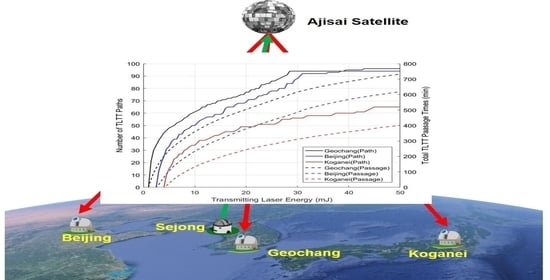Link Budget Analysis with Laser Energy for Time Transfer Using the Ajisai Satellite
Abstract
:1. Introduction
2. TLTT Link Budget
2.1. Link Budget Equation for TLTT
2.1.1. Free Space Loss and Atmospheric Effects for TLTT
2.1.2. Effective Cross Section of Ajisai’s Mirror for TLTT
2.2. Minimum Required Laser Energy for TLTT
3. Simulation Results
3.1. Simulation Parameters
3.1.1. Characteristics of Ajisai for TLTT
3.1.2. Parameters of SLR Stations in the Target Network
3.2. Results
3.2.1. Effects of Geometric Configuration
3.2.2. Optimal Laser Energy
4. Discussion
Author Contributions
Funding
Institutional Review Board Statement
Informed Consent Statement
Data Availability Statement
Acknowledgments
Conflicts of Interest
References
- Kirchner, D. Two-Way Time Transfer via Communication Satellites. Proc. IEEE 1991, 79, 983–990. [Google Scholar] [CrossRef]
- Freelance, P.; Veillet, C. Operation and data analysis in the LASSO experiment. Metrologia 1995, 32, 27–33. [Google Scholar] [CrossRef]
- Fridelance, P.; Samain, E.; Veillet, C. T2L2—Time Transfer by Laser Link: A New Optical Time Transfer Generation. Exp. Astron. 1997, 7, 191–207. [Google Scholar] [CrossRef]
- Vrancken, P. Characterization of T2L2 (Time Transfer by Laser Link) on the Jason 2 Ocean Altimetry Satellite and Micrometric Laser Ranging. Ph.D. Thesis, Université de Nice, Sophia-Antipolis, Nice, France, 2008. [Google Scholar]
- Samain, E.; Weick, J.; Vrancken, P.; Para, F.; Albanese, D.; Paris, J.; Torre, J.-M.; Zhao, C.; Guillemot, P.; Petitbon, I. Time transfer by laser link—The T2L2 experiment on Jason-2 and further experiments. Int. J. Mod. Phys. D 2008, 17, 1043–1054. [Google Scholar] [CrossRef] [Green Version]
- Samain, E.; Vrancken, P.; Guillemot, P.; Fridelance, P.; Exertier, P. Time transfer by laser link (T2L2): Characterization and calibration of the flight instrument. Metrologia 2014, 51, 503–515. [Google Scholar] [CrossRef] [Green Version]
- Sasaki, M.; Hashimoto, H. Launch and Observation Program of the Experimental Geodetic Satellite of Japan. IEEE Trans. Geosci. Remote Sens. 1987, GE-25, 526–533. [Google Scholar] [CrossRef]
- Kunimori, H.; Takahashi, F.; Itabe, T.; Yamamoto, A. Laser ranging application to time transfer using geodetic satellite and to other Japanese space programs. In Proceedings of the 8th international Workshop on Laser Ranging Instrumentation, Annapolis, MD, USA, 18–22 May 1992; pp. I-34–I-42. [Google Scholar]
- Kucharski, D.; Kirchner, G.; Otsubo, T.; Kunimori, H.; Jah, M.K.; Koidl, F.; Bennett, J.C.; Lim, H.; Wang, P.; Steindorfer, M.; et al. Hypertemporal photometric measurement of spaceborne mirrors specular reflectivity for Laser Time Transfer link model. Adv. Space Res. 2019, 64, 957–963. [Google Scholar] [CrossRef]
- Otsubo, T.; Kunimori, H.; Gotoh, T. New Application for Khz Laser Ranging: Time Transfer Via Ajisai. In Proceedings of the 15th international Workshop on Laser Ranging, Canberra, Australia, 15–20 October 2006; pp. 420–424. [Google Scholar]
- Degnan, J.J. Millimeter Accuracy Satellite Laser Ranging: A Review. In Contributions of Space Geodesy to Geodynamics: Technology; Smith, D.E., Turcotte, D.L., Eds.; AGU: Washington, DC, USA, 1993; Volume 25, pp. 133–162. [Google Scholar]
- Lim, H.; Seo, Y.; Na, J.; Bang, S.; Lee, J.; Cho, J.; Park, J.H.; Park, J. Tracking Capability Analysis of ARGO-M Satellite Laser Ranging System for STSAT-2 and KOMPSAT-5. J. Astron. Space Sci. 2010, 27, 245–252. [Google Scholar] [CrossRef] [Green Version]
- Kucharski, D.; Kirchner, G.; Otsubo, T.; Lim, H.; Bennett, J.; Koidl, F.; Kim, Y.; Hwang, J. Confirmation of gravitationally induced attitude drift of spinning satellite Ajisai with Graz high repetition rate SLR data. Adv. Space Res. 2016, 57, 983–990. [Google Scholar] [CrossRef]
- Kucharski, D.; Kirchner, G.; Otsubo, T.; Koidl, F. The impact of solar irradiation on Ajisai’s spin period measured by the Graz 2 kHz SLR system. IEEE Trans. Geosci. Remote Sens. 2010, 48, 1629–1633. [Google Scholar] [CrossRef]
- Hattori, A.; Otsubo, T. Time-varying solar radiation pressure on Ajisai in comparison with LAGEOS satellite. Adv. Space Res. 2019, 63, 63–72. [Google Scholar] [CrossRef]
- Otsubo, T.; Amagai, J.; Kunimori, H.; Elphick, M. Spin motion of the Ajisai satellite derived from spectral analysis of laser ranging data. IEEE Trans. Geosci. Remote Sens. 2000, 38, 1417–1424. [Google Scholar] [CrossRef]
- Kirchner, G.; Hausleitner, W.; Crisrea, E. Ajisai spin parameter determination using Graz kilohertz satellite laser ranging data. IEEE Trans. Geosci. Remote Sens. 2007, 45, 201–205. [Google Scholar] [CrossRef]
- International Laser Ranging Service. Available online: https://ilrs.gsfc.nasa.gov/network/stations/index.html (accessed on 2 April 2021).
- Vallado, D.; Crawford, P. SGP4 Orbit Determination. In Proceedings of the AIAA/AAS Astrodynamics Specialist Conference, Honolulu, HI, USA, 18-21 August 2008; p. AIAA-2008-6770. [Google Scholar] [CrossRef]
- CelesTrak: Current NORAD Two-Line Element Sets. Available online: https://www.celestrak.com/NORAD/elements (accessed on 29 March 2021).
- International Earth Rotation and Reference System Service. Available online: https://www.iers.org/IERS/EN/Science/EarthRotation/EOP.html (accessed on 29 March 2021).
- Zhang, Z.; Yang, F.; Zhang, H.; Wu, Z.; Chen, J.; Li, P.; Meng, W. The use of laser ranging to measure space debris. Res. Astron. Astrophys. 2012, 12, 212–218. [Google Scholar] [CrossRef] [Green Version]
- Kirchner, G.; Koidl, F.; Friederich, F.; Buske, I.; Völker, U.; Riede, W. Laser measurements to space debris from Graz SLR station. Adv. Space Res. 2013, 51, 21–24. [Google Scholar] [CrossRef]
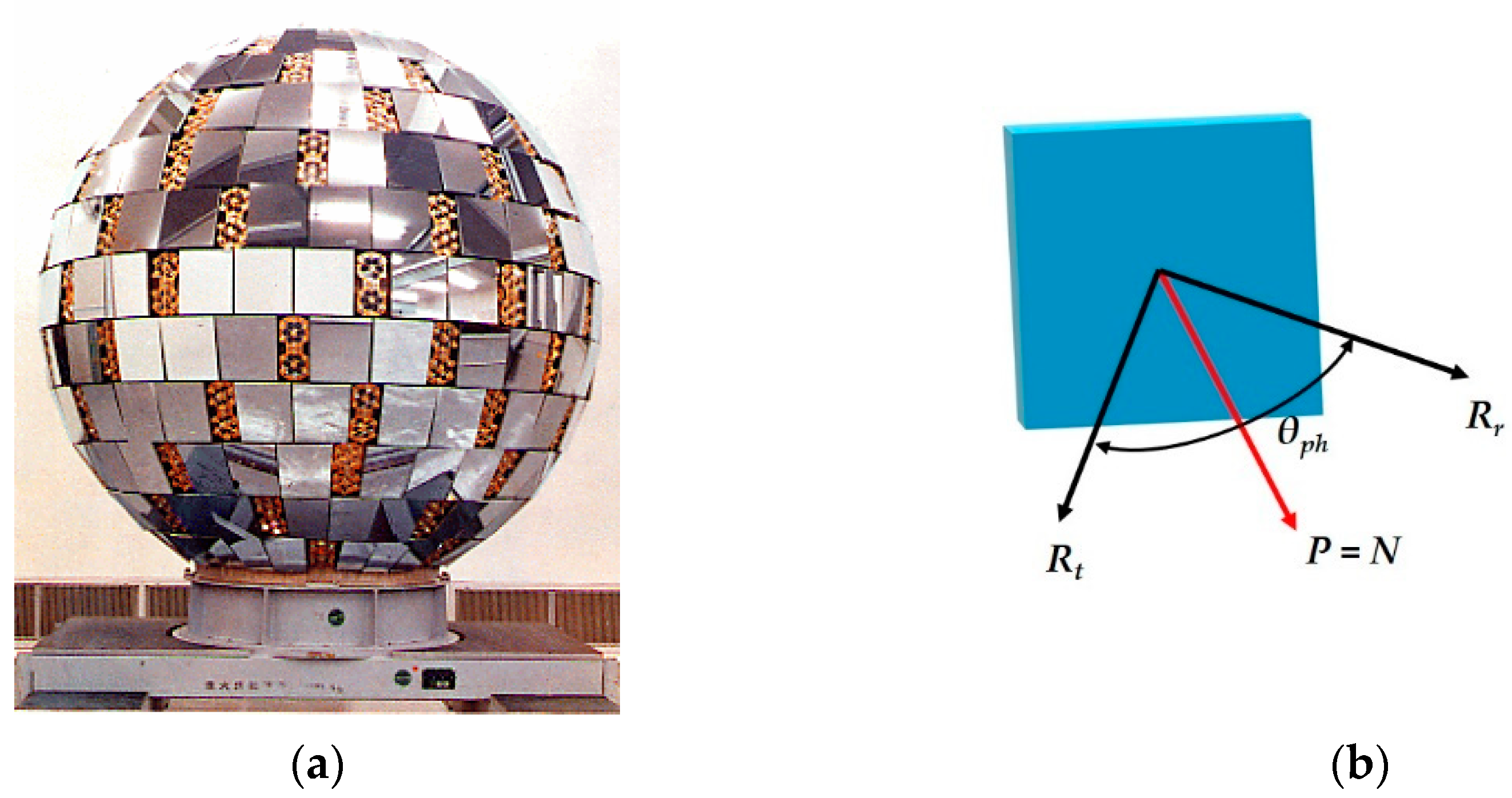
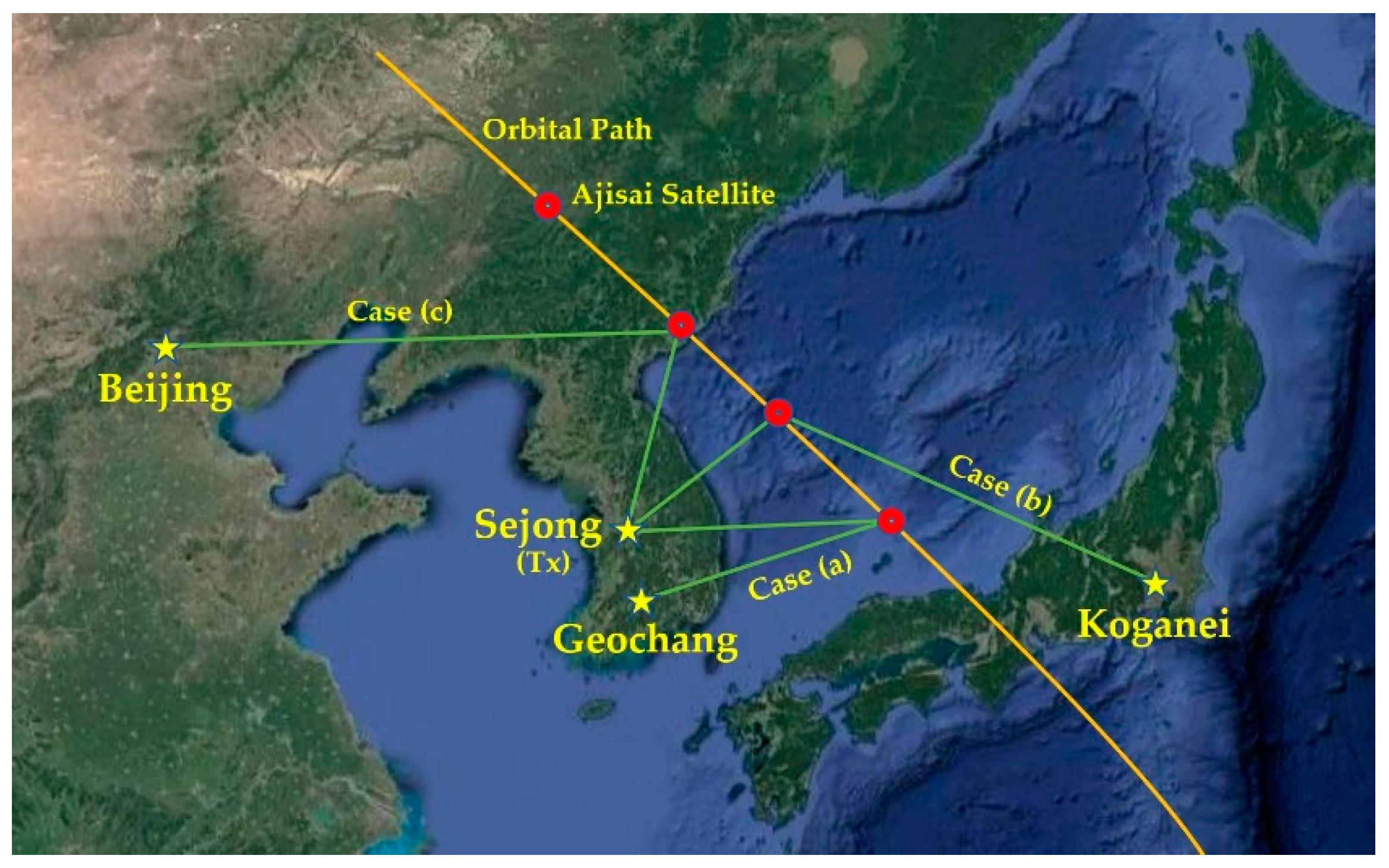


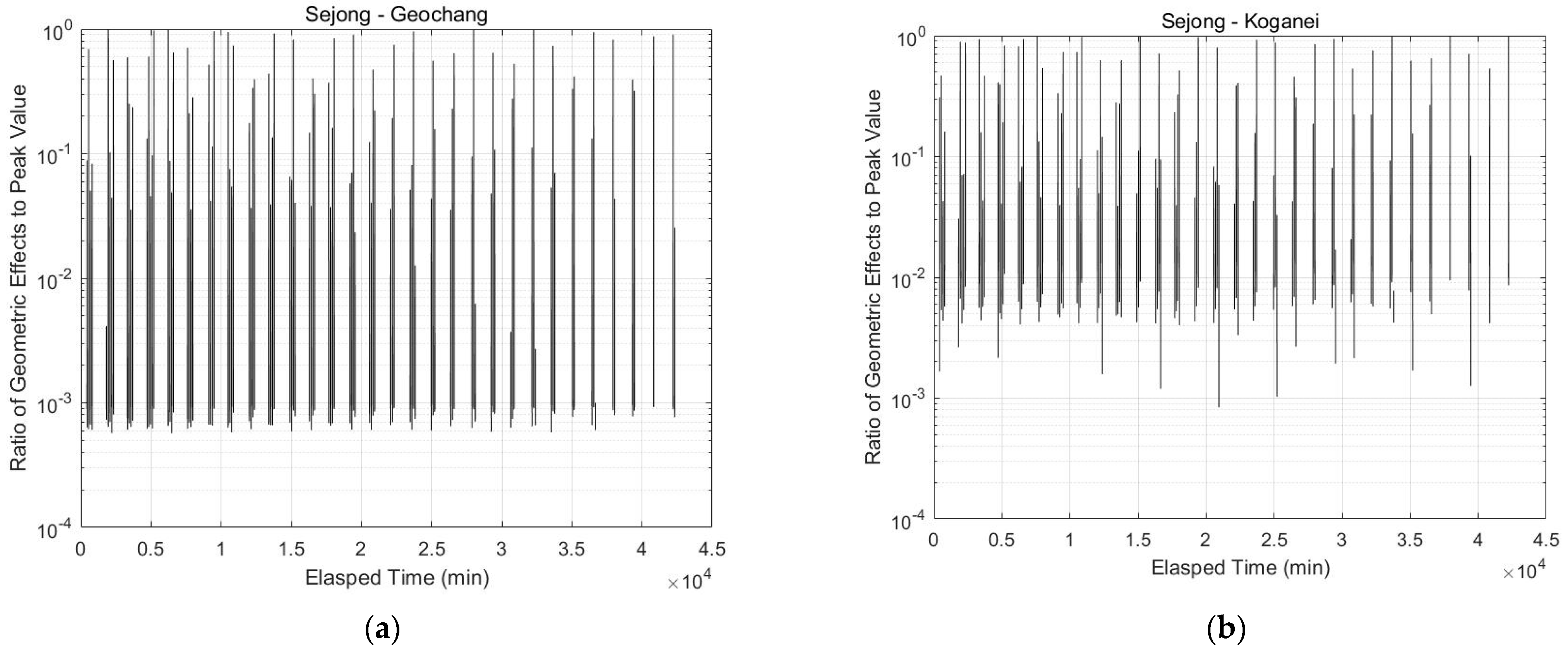
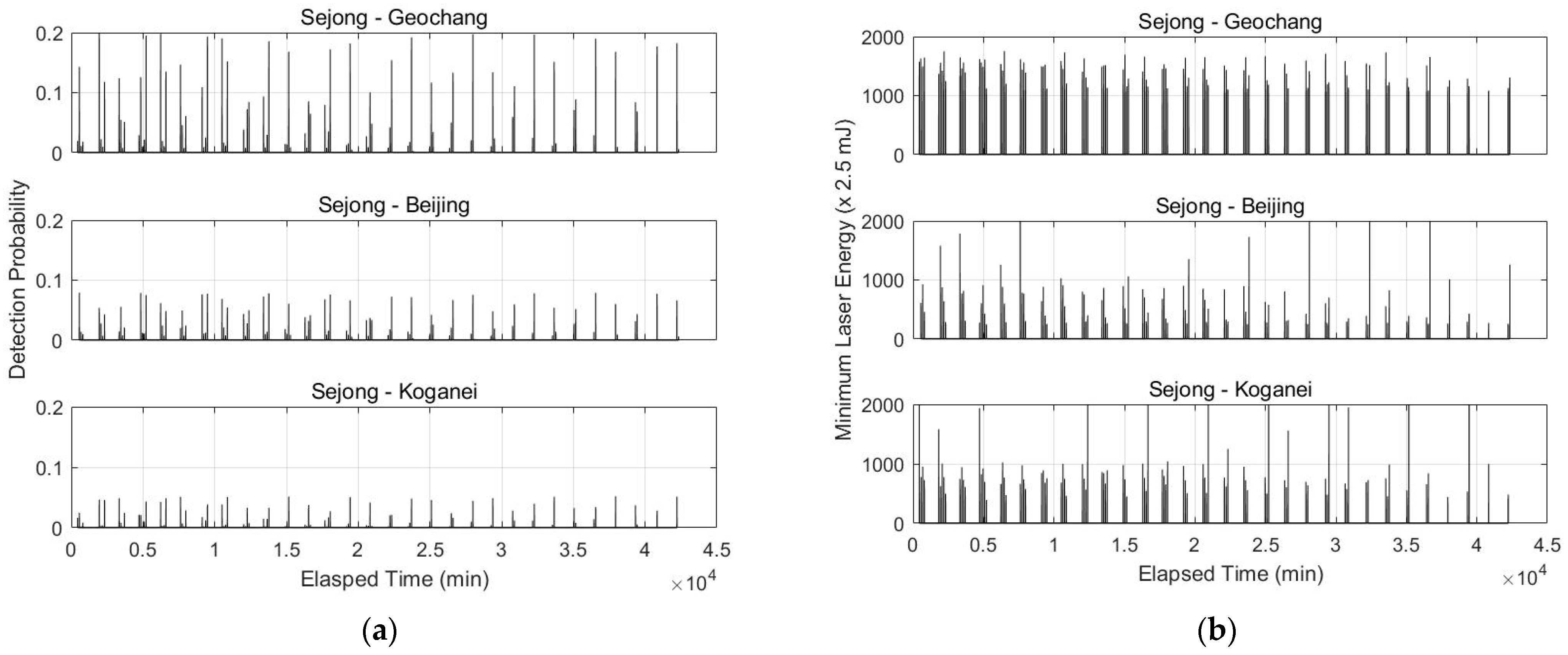



| Number of mirrors | 318 pieces |
| Curvature of mirrors | 8.35~8.7 m (8.5 m for simulation) |
| Reflectivity | 0.85~0.92 (0.85 for simulation) |
| Duration of light flash | 5 msec |
| Rate of flashing | 1.25 Hz (2 Hz at initial) |
| Spin rate | 25 rpm (40 rpm at initial) |
| Parameters | Sejong | Geochang | Beijing | Koganei | ||
|---|---|---|---|---|---|---|
| Laser | λ | Wavelength | 532 nm | 532 nm | 532 nm | 532 nm |
| Pulse energy | 2.5 mJ | 15 mJ | 1 mJ | 50 mJ | ||
| Pulse width | 50 ps | 9.2 ps | 200 ps | 35 ps | ||
| Repetition rate | 1 KHz | 60 Hz | 1 KHz | 20 Hz | ||
| Telescope | Tx Primary mirror | 0.1 m | 1.0 m | 0.16 m | 1.5 m | |
| Tx Secondary mirror | - | 0.25 m | - | |||
| Transmit optic efficiency | 92.3% | 75% | 70% | 30% | ||
| Beam divergence angle | 5~200 arcsec | 8 arcsec | <103 arcsec | 5 arcsec | ||
| Beam pointing error | <5 arcsec | <4 arcsec | <5 arcsec | <5 arcsec | ||
| Rx Primary mirror | 0.4 m | 1.0 m | 0.60 m | 1.5 m | ||
| Rx Secondary mirror | 0.1 m | 0.25 m | - | - | ||
| Receiver optic efficiency | 64.9% | 35% | 70% | 10% | ||
| Detector | Quantum efficiency | 20% | 20% | 20% | 15% | |
| Position | Longitude | 127.3029E | 127.9201E | 115.8920E | 139.489E | |
| Latitude | 36.5210N | 35.5902N | 39.6069N | 35.710N | ||
| Altitude | 176.415 m | 934.063 m | 82.300 m | 121.820 m | ||
| Laser Energy | Number of TLTT Paths | Total TLTT Passage Times (min) | ||||
|---|---|---|---|---|---|---|
| Geochang | Beijing | Koganei | Geochang | Beijing | Koganei | |
| 2.5 mJ | 0(0%) | 0(0%) | 0(0%) | 0 | 0 | 0 |
| 5.0 mJ | 48(47%) | 33(33%) | 15(16%) | 238.3 | 104.4 | 26.0 |
| 10.0 mJ | 61(60%) | 50(50%) | 34(36%) | 359.7 | 232.5 | 131.5 |
| 25.0 mJ | 86(84%) | 78(79%) | 51(54%) | 561.6 | 433.2 | 278.6 |
| 50.0 mJ | 96(94%) | 94(95%) | 65(68%) | 732.5 | 618.1 | 400.7 |
| Observable | 102 | 99 | 95 | 1163.8 | 930.5 | 837.6 |
Publisher’s Note: MDPI stays neutral with regard to jurisdictional claims in published maps and institutional affiliations. |
© 2021 by the authors. Licensee MDPI, Basel, Switzerland. This article is an open access article distributed under the terms and conditions of the Creative Commons Attribution (CC BY) license (https://creativecommons.org/licenses/by/4.0/).
Share and Cite
Park, J.U.; Lim, H.-C.; Sung, K.-P.; Choi, M. Link Budget Analysis with Laser Energy for Time Transfer Using the Ajisai Satellite. Remote Sens. 2021, 13, 3739. https://0-doi-org.brum.beds.ac.uk/10.3390/rs13183739
Park JU, Lim H-C, Sung K-P, Choi M. Link Budget Analysis with Laser Energy for Time Transfer Using the Ajisai Satellite. Remote Sensing. 2021; 13(18):3739. https://0-doi-org.brum.beds.ac.uk/10.3390/rs13183739
Chicago/Turabian StylePark, Jong Uk, Hyung-Chul Lim, Ki-Pyoung Sung, and Mansoo Choi. 2021. "Link Budget Analysis with Laser Energy for Time Transfer Using the Ajisai Satellite" Remote Sensing 13, no. 18: 3739. https://0-doi-org.brum.beds.ac.uk/10.3390/rs13183739





